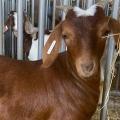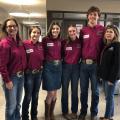Replacement Beef Heifer Development Contest

L-R: Beth Tartt (B&B Cattle Co.); Nina/Luke Hay (5th place); Caleb French (finalist); Owen Massey (2nd place); Logan Cushman (1st place); Caycen Ratliff (3rd place); Grace Randle (4th place); and Roy Higdon (contest superintendent).
Download the
Entry Form
here
Objective
4-H & FFA livestock projects have been one of the most successful activities at teaching youth and their family about responsibility and care for their livestock. The objective of the 4-H/FFA Replacement Beef Heifer Development Contest is to recognize youth who have a true passion for raising beef cattle. This is a ten (10) month contest where the contestant would be personally responsible for the daily management of their heifers. In competing in the heifer development contest, it is anticipated that the participants and adults around the state will learn proper heifer development practices and procedures. The contest is designed to encourage young beef producers to participate in a practical beef heifer development program.
Design of Contest
The 4-H & FFA Heifer Development Contest is a ten (10) month project. It will start on November 1, 2024, and conclude on the final contest weekend in early August 2025. An entry form is required prior to November 1 to be submitted to Dr. Dean Jousan, Extension 4-H Livestock Specialist. The location of the final portion of contest will be determined later.
4-H & FFA members must be individual entrants to the contest unless two (2) or more brothers or sisters, each at least 14 years of age but not over 18 years of age as of January 1 of the current year in which the contest begins, of a family constitute a joint entry. If the entrant is in college, he/she must personally manage and care for their heifers daily by commuting from home to school. It is not permissible to have someone else care for the heifers while away at school.
The heifer development project must consist of three (3) heifers (purebred or commercial) that are either fall born from the previous year or spring born of the current year in which the contest begins. While not mandatory, the heifers can be exhibited in junior shows. Heifers can be purchased from a purebred or commercial producer or be selected from family operations of an immediate family member (parent, stepparent, brother, sister, half-brother, half-sister, grandparent or legal guardian). NOTE: If registered or commercial beef heifers are used in the project and are to be shown at the Mississippi State Fair or District and Dixie National Junior Round-Up Livestock Shows, the ownership rules and regulations as printed in those premium books will still apply.
This contest is designed to evaluate the youth producer’s ability to manage the heifers rather than the genetic selection of the heifers. Therefore, participants using purebred and commercial heifers will be judged together without preference given to breed or breed type.
Contestants will be judged on all managerial aspects of their heifer development project. Youth can take advantage of FSA farm loans totaling $5,000. Participants will be encouraged to take advantage of Extension agents, advisors and experienced producers in selecting quality heifers and discussing production cost.
Evaluation System
By November 1, 2024, an entry form must be submitted to the Extension 4-H Livestock Specialist. This will determine the number of contestants and create a record of preliminary information about heifers selected for this project. Initial criteria to be included on the entry form would include the animals’ age, weight, breed, and starting value (purchase price) for each animal. In addition, each entrant should submit their goals for the project. If registered heifers are used, the entry should include a photocopy of that animal(s) registration paper.
Potential heifers to be chosen for the contest should be born in the fall of 2023 or the spring of 2024. Any heifer with a sign of 3-year-old teeth will be eliminated at the contest site, regardless of a registered or printed birth date for that heifer.
All participants must submit a record book prior to evaluation of the heifers that must be postmarked to me no later than July 23, 2025. Records could be kept in a spreadsheet, notebook or other system that is decided upon by the exhibitor(s). Specific records that should be kept throughout the year and submitted can be found in the Records section below. Entrants will be notified by letter where the record books should be sent closer to the deadline.
All three (3) heifers entered in the contest should be taken to the contest site for final judging. No heifer may be substituted during the contest. In addition, before a heifer is removed from the contest for a management reason, please notify Roy Higdon (rafterh@zimbracloud.com), Libby Durst (lsd83@msstate.edu), or Dean Jousan (Dean.Jousan@msstate.edu) beforehand.
The 4-H & FFA Heifer Development Contest will be made up of 3 components: a visual appraisal of the heifers, a record keeping system and an interview process.
- Visual Evaluation: A committee of judges will evaluate each group of three (3) heifers managed by the contestant. Criteria that will be evaluated include weight, frame score, growth, body condition score, health, structural/skeletal soundness, and pregnancy status. Exhibitors should provide a letter from their veterinarian that summarizes the pregnancy status of each their heifer (whether each heifer is bred and for how many days) or submit a copy of the pregnancy status results if a pregnancy determination kit was used. In addition, each entrant will be judged on their overall knowledge of phenotypic characteristics of their heifers. This component of the contest will be worth 20%.
- Records: Youth will be required to submit records kept throughout the entire ten (10) month project. At the start of the project, contestants will be asked to list short- and long-term goals for their heifer project. In addition, during each month of the project, the contestant should record anything that was done to his/her heifers. Examples would include recording the amount of feed, hay or other nutritional supplements purchased or fed, veterinarian expenses and other health-related costs, breeding decisions, rotational grazing of pastures, a complete budget/expense sheets and any other management issue in which the youth had to decide for the continued development of his/her heifers. At the conclusion of the project, youth should address whether they were able to achieve the goals that they set at the start of the project. These records will be judged on their completeness and exactness during the contest year. This component of the contest will be worth 30%.
- Interview: A committee of judges will interview the exhibitor on their individual production practices. The exhibitor will give a presentation (PowerPoint is recommended) to summarize his/her heifer development project. This presentation can include anything relevant to the contestant’s project (goals for project and if they were accomplished, pictures to illustrate the project, etc.). Each exhibitor will then answer questions from the committee regarding their project, such as the process used to select the heifers, record keeping system used, nutrition program, bull used for breeding purposes, health records and any production practices utilized by the exhibitor during this contest. This component of the contest will be worth 50%.
The criteria that will make up each category will be determined by a committee of individuals including, but not limited to, area livestock agents, cattle producers, and extension specialists and cattle association members. All ties would be broken using the interview score followed by the record book. The committee of judges for the contest would include the same type of individuals mentioned in this paragraph within Mississippi or in nearby states.
Awards
Awards will be announced when the results are presented at the MS State Fair before the start of beef showmanship. The past overall winning individual/team cannot compete in future 4-H/FFA Replacement Beef Heifer Development Contests. However, if a team of siblings competes, they can declare one (1) person on that team to receive the awards associated with their final placing. This designation must be made by final record submission or at check-in of the heifers at the contest site. To fund this project, sponsorship is sought from industry, county cattlemen’s associations, breed associations, and individuals recognizing the value and importance of this contest. Your tax-deductible donation can be made to the Mississippi Cattlemen’s Foundation and earmarked for the Heifer Development Project.
Disclaimer: Awards and prizes awarded each year are subject to change without prior notice and are established on a yearly basis based on sponsorships.
Importance of Project
This contest should provide an authentic experience for youth that choose to participate in this contest. Not only will youth learn valuable information that they can use for a lifetime, but the cattle industry can benefit as young cattlemen and cattlewomen will be educated producers in the future. These youth can be a positive influence on their own family’s cattle production system and share their insights with other cattle producers around the state, causing adults to think more about their own management decisions too.
Sponsors
The 4-H/FFA Replacement Beef Heifer Development Contest would not be possible without the support of numerous individuals and businesses. Our 2022-2023 sponsors include: Bob Robinson; American Livestock Insurance; B&B Cattle Co.; Boot Country; Bouie River Beefmasters; Campo Farms; Castle Grove Plantation; Carcass Performance Partners Bull Sale – Ricky & Gay Nicholas; Havard Pest Control; Hearz Your Sign; Jackson Power Train; McDaniel Farms; MG 4M Farms; MERCK Animal Health; Mississippi Ag Company; Mississippi Cattlemen’s Association; Mississippi Simmental/Simbrah Association; Mississippi State University Extension; Red Fox Angus Farm; Southern Producers Heifer Sale Group; Rutland Livestock; Spur W Farms; Triple S Land and Cattle; and Vowell Farms.
Previous Contest Winners
2023-2024 Contest
Contest ongoing.
2022-2023 Contest
1st – Owen Massey, Forrest County
2nd – Caycen Ratliff, Stone County
3rd – Leah Walker, DeSoto County
4th – Ann Rileigh Holder, Jones County
5th – Grace Randle, Pontotoc County
Finalist – Jadyn Collier, Winston County
2021-2022 Contest
1st – Logan Cushman, Smith County
2nd – Owen Massey, Forrest County
3rd – Caycen Ratliff, Stone County
4th – Grace Randle, Pontotoc County
5th – Luke/Nina Hay, Lauderdale County
Finalist – Caleb French, Neshoba County
2020-2021 Contest
1st – Cheyenne Hughes, Tishomingo County
2nd – Nina Hay, Lauderdale County
3rd – Elizabeth Rone, Panola County
4th – Luke Hay, Lauderdale County
5th – Hannah Buse, Jones County
Finalist – Laney Anderson, Lincoln County
Finalist – Grace Randle, Pontotoc County
Finalist – Dru Prisock, Oktibbeha County
Finalist – Faith Sullivan, Smith County
2019-2020 Contest
1st – Noah Carpenter, Tishomingo County
2nd – Cheyenne Hughes, Tishomingo County
3rd – Hannah Buse, Jones County
4th – Faith Sullivan, Smith County
5th – Luke Hay, Lauderdale County
Finalist – Elizabeth Rone, Panola County
Finalist – Nina Hay, Lauderdale County
Finalist – Adaline Rouse, Jackson County
2018-2019 Contest
1st – Anna Nelson, Walthall County
2nd – Laney Anderson, Lincoln County
3rd – Noah Carpenter, Tishomingo County
4th – Nina Hay, Lauderdale County
5th – Elizabeth Rone, Panola County
Finalist – Hannah Buse, Jones County
Finalist – Taylor Vowell, Leake County
Finalist – Brandt Sowell, Madison County
2017-2018 Contest
1st – Rylie Melancon, Lincoln County
2nd – Mary Beth Ainsworth, Lawrence County
3rd – Olivia Branum, Pearl River County
4th – Marlee Turner, Alcorn County
5th – Laney Anderson, Lincoln County
Finalist – Anna Vowell, Leake County
Finalist – Jenna Fullington, Hinds County
Finalist – Brandt Sowell, Madison County
Finalist – Jace Welborn, Jasper County
2016-2017 Contest
1st – Amelia Buckley, Covington County
2nd – Olivia Branum, Pearl River County
3rd – Trent Howe, Stone County
4th – Anna Vowell, Leake County
5th – Nathan Pulliam, Stone County
Finalist – Colleen Ellzey, Jones County
Finalist – Ashleigh Hickman, Forrest County
Finalist – Claire Posey, Lincoln County
Finalist – Rowdy Anderson, Jones County
Finalist – Meribeth Hales, Lauderdale County
Finalist – Justin Klunk, Pike County (Justin passed away in a tragic accident a few days after completing the contest. He was passionate about trading cattle and enjoyed outdoor activities and the Pike County 4-H Club. He will always be remembered for his excitement for this contest.)
2015-2016 Contest
1st – Rustin Anderson, Jones County
2nd – Claire Harris, Scott County
3rd – Olivia Branum, Pearl River County
4th – Danielle Solomon, Marion County
5th – Amelia Buckley, Covington County
Finalist – Will Watts, Lincoln County
Finalist – Macey Nelson, Pike County
Finalist – Kalyn Smith, Leake County
Finalist – Emma O’Neal, Tate County
Finalist – Colt Prisock, Oktibbeha County
Finalist – Justin Klunk, Pike County
Finalist – Meribeth Hales, Lauderdale County
2014-2015 Contest
1st – Emily Vowell, Smith County
2nd – Danielle Solomon, Marion County
3rd – Justin Klunk, Pike County
4th – Colt Prisock, Oktibbeha County
5th – Emma O’Neal, Tate County
2013-2014 Contest
1st – Jonah Bankston, Pike County
2nd – Katlyn Harris, Scott County
3rd – Emily Vowell, Smith County
4th – J.T. Prisock, Oktibbeha County
5th – Colt Prisock, Oktibbeha County
2012-2013 Contest
1st – Will Gibson, Newton County
2nd – Cameron Crawford, Pike County
3rd – Cheyenne Ladner, Pearl River County
4th – Natalie McCormick, Pearl River County
5th – J.T. Prisock, Oktibbeha County
6th – Jacob Manning, Forrest County
2011-2012 Contest
1st – Jimmy Stewart, Stone County
2nd – Will Gibson, Newton County
3rd – Lane Gandy, Covington County
4th – Jacob Stewart, Stone County
5th – Cameron Crawford, Pike County
6th – Josh Vowell, Smith County
7th – Chip Gibson, Lee County
2010-2011 Contest
1st – Jessica Smith, Pearl River County
2nd – Corrine Jackson, Webster County
3rd – Jimmy Stewart, Stone County
4th – Josh Vowell, Smith County
5th – Morgan Lane, Stone County
6th – Morgan Howe, Stone County
2009-2010 Contest
1st – Arizona Parden, Stone County
2nd – Josh Vowell, Smith County
3rd – Corrine Jackson, Webster County
4th – Tyler Neal, Scott County
5th – Ty Ladner, Pearl River County
6th – Daniel Wicker, Franklin County
2008-2009 Contest
1st – Michael Buckley, Covington County
2nd – Alan Smith, Pearl River County
3rd – Chelsea Adams, Marion County
4th – Bonnie Tartt, Lauderdale County
5th – Garrett Bond, Stone County
6th – Cody Maske, Newton County
7th – Wes Herrington, Jones County
8th – J.J. Hitt, Calhoun County
9th – Matthew Baxter, Stone County
Publications
News
While Mississippi high school students have history, English and algebra on their schedules, several are now adding advanced animal husbandry skills to their academic load.
Brandi Karisch, beef cattle specialist with the Mississippi State University Extension Service, said Extension began offering a youth stockmanship competition this year to improve young participants’ knowledge and skills in beef cattle handling.
RAYMOND, Miss. -- Not so long ago, goats were niche livestock animals in Mississippi. But these small ruminants have grown in popularity in recent years, especially dairy goats. Farmers who have limited acreage or want to diversify their livestock operations often choose goats. Others want goats for their meat or milk. Regardless of the purpose, people who want to join the ranks of goat owners should understand some important aspects of goat ownership before bringing one home.
JACKSON, Miss. -- Since the age of 7, Smith County 4-H’er Chase Boone has been showing mostly Simmental cattle in the Dixie National Junior Round-Up each year.
Success Stories
She knew she wanted to teach even when she was just a kid, but Dr. Molly Nicodemus also realized pretty quickly that she wanted to teach older students at the college level. Now an associate professor in the Department of Animal and Dairy Sciences at Mississippi State University, Nicodemus has embraced a new teaching role with adolescents and teens as a volunteer leader for the Winston County 4-H Horse Club.
In late February, Mississippi State University hosted the 2024 National Floriculture Forum, an annual conference held at different locations around the country.
She grew up in the 4-H youth development program in Indiana, and her husband was in Ohio 4-H. Fast-forward a few years, and Inez Saum became a volunteer leader for Mississippi 4-H.









